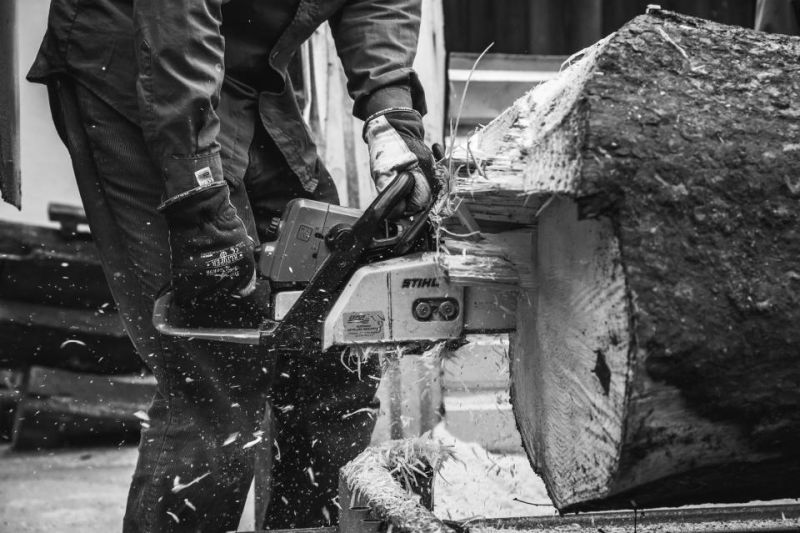Holmes County home to prime land for timber industry
Timber is big business in Holmes County. According to 2012 research from the Ohio State University, logs and roundwood come in as the number-three agricultural product in the county, right after dairy and poultry products. With roughly one-third of land in Holmes County forested, this number comes as no surprise. Timber is one of the things that makes Holmes County a special place.
“You have to understand,” said Dr. Gary Graham, natural resources specialist with the Ohio State University Extension in Millersburg, “Holmes County is unique with small farms. You have all of these little patchwork plots of forest, grain, pasture, tilled fields and homes.”
Elsewhere in the United States, particularly in western states, that is not the case. Forested areas are often left to the trees because they are unsuitable for agriculture in general. But here there is still a lot of prime land that is used for timber, and that is one reason why wood products are such a major part of the local economy.
To give an indication of just how large this industry is, OSU’s 2012 research showed that businesses related to the local timber economy generated $421 million in industrial output yearly, generating about $24.7 million in taxes.
So what is all of this lumber used for? A portion of the county’s timber output goes into the Amish manufacturing community in Holmes and surrounding counties. In 2012 a survey conducted jointly by OSU, OARDC and the U.S. Forest Service showed that household furniture made up 80.6 percent of the wood products produced in the region, followed by office furniture, cabinets, dimensional lumber and mill work in that order.
Furniture production is what puts Holmes County in the international spotlight. Elsewhere in the United States the furniture industry is on a decline because of competition from overseas manufacturers who can create mass-produced furnishings at a lower cost.
In Holmes County, however, the story is a little different. People from all over the United States look to the Amish furniture industry as a source of unique, high-quality pieces that come with a level of customization unlike anything that can be purchased anywhere else.
“You have somebody that buys furniture,” Graham said. “Let’s say they start out with the bed. Maybe two or three years later they want to get dressers or an armoire, something else to go with the bed. They don’t even have to go back to the same manufacturer, but they can get the same style, the same species and even the exact same color because our local furniture group has a set standard of stains.
The timber industry has done a very good job at paying attention to grading. In other words they’re making sure the wood is appropriate for the manufacturers. So everyone works hand in hand getting the logs. They mill it to make sure it is the right kind of wood, the right grain. Everything from the sawmill is top notch.”
It is this community of businesses all working together on a common set of goals that keeps customers coming back for more.
Codi Mast, marketing director at Homestead Furniture in Mt. Hope, agrees with these sentiments. “It’s kind of like a cluster industry,” she said. “We try to boost the local economy and get as much done as effectively as we can. For example, our drawer boxes, we don’t make those because we can’t do it as cost effectively or as efficiently as another manufacturer in this area, so we have a guy that makes only drawer boxes, and he makes them efficiently to our standards, a high-quality product.”
With the local furniture industry booming, there is plenty of opportunity to put the forested acres of Holmes County to work. Many landowners already timber their forested lands, either through clear cutting or selective timbering, but to maximize on profits and keep the forest healthy, Graham said the best bet is to manage forests with the help of a forester consultant.
“They’ll help you by looking at your woods,” he said. “They’ll be able to tell you what is valuable. They know what the market is and what’s hot. Cherry might be valuable one spring, but come fall, it’s not.”
It’s a lot like playing the stock market, and just like the stock market, it helps to have an expert advising you on which trees to sell and which to hold.
On the surface timber management sounds like an easy way to make money, but there are many challenges and concerns that would-be forest managers should consider. For instance it is unwise to rely on one species as a source of income. With the way prices rise and fall, trees of a certain species can go from boom to bust as the seasons turn.
Additionally single-species forests can suffer devastating losses to disease or invasive species. Chestnut trees, for example, were once a dominant species throughout Ohio, but a blight nearly wiped them out, allowing other types of trees to take over. This is another good reason why a forester consultant can be helpful: to help woodlot owners pick and choose the types of trees to keep in their own slice of forest.
Speaking of invasive species, this is a problem everyone involved in the timber industry should be watching. “Ash is being wiped out by the emerald ash borer,” Graham said. “We have hemlock woolly adelgid, which attacks hemlock trees. We have Asian longhorn beetle, which we’re trying to contain.”
There are a variety of invasives in Ohio currently that have the potential to seriously damage forests or that have already caused serious damage. To learn more about invasive species or to report a sighting, it is recommended one contact the Extension office. One also can contact the Extension office for more information about timber management and the local timber economy as a whole.

